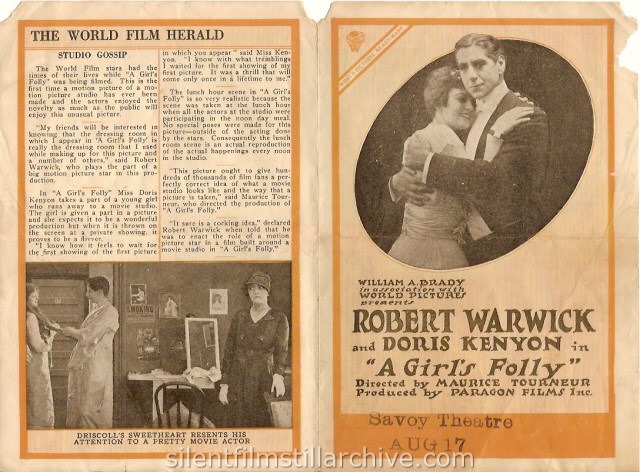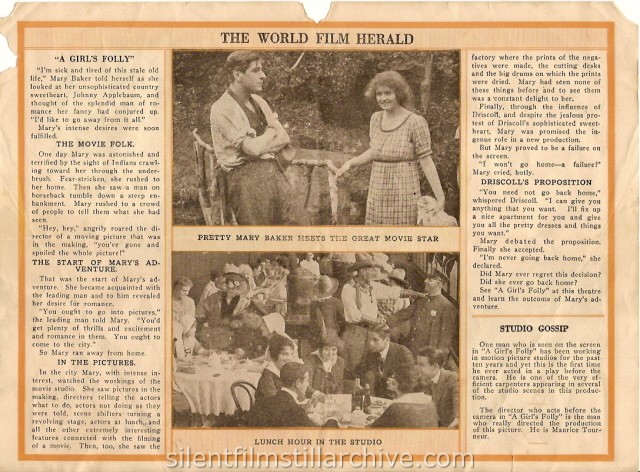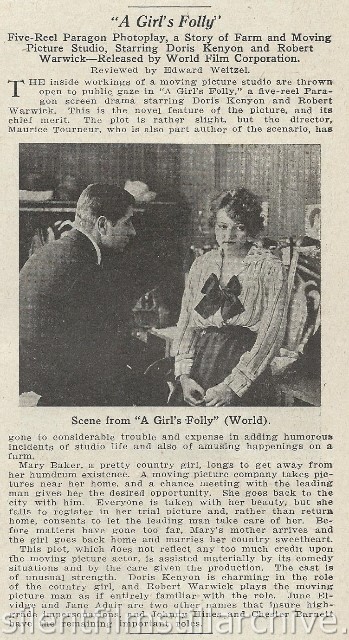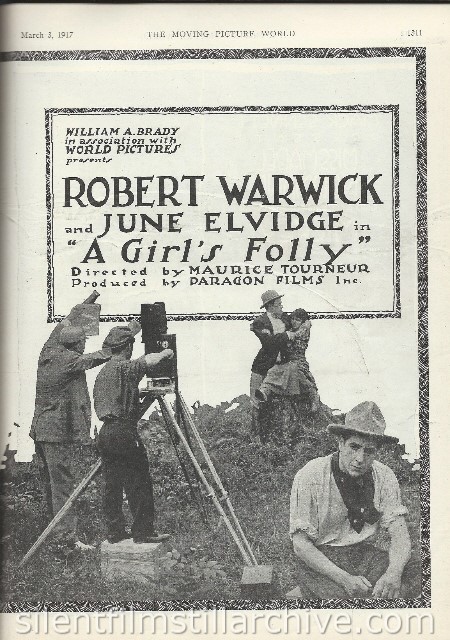![]()

A Girl's Folly (1917)

William A Brady in association with WORLD PICTURES presents
ROBERT WARWICK and DORIS KENYON in
"A Girl's Folly"
Directed by Maurice Tourneur
Produced by Paragon Films Inc.
Savoy Theatre Aug. 17
STUDIO GOSSIP
One man who is seen on the screen in "A Girl's Folly" has been working in motion picture studios for the past ten years and yet this is the first time he ever acted in a play before the camera. He is one of the very efficient carpenters appearing in several of the studio scenes in this production.
---
The director who acts before the camera in "A Girl's Folly" is the man who really directed this picture. He is Maurice Tourneur.
---
The World Film stars had the times of their lives while "A Girl's Folly" was being filmed. This is the first time a motion picture of a movie studio has ever been made and the actors enjoyed the novelty as much as the public will enjoy this unusual picture.
---
"My friends will be interested in knowing that the dressing room in which I appear in "A Girl's Folly" is really the dresing room that I used while making up for this picture and a number of others", said Robert Warwick, who plays the part of a big motion picture star in this production.
---
In "A Girl's Folly" Miss Doris Kenyon takes a prt of a young girl who runs away to a movie studio. The girl is given a part in a picture and she expects it to be a wonderful production but when it is thrown on the screen at a private showing, it proves to be a flivver.
I know how it feels to wait for the first showing of the first picture in which you appear" said Miss Kenyon. "I know with what tremblings I waited for the first showing of my first picture. It was a thrill that will come only once in a lifetime to me."
---
The lunch hour scene in "A Girl's Folly" is so very realistic because the scene was taken at the lunch hour when all the actors at the studio were participating in the noon day meal. No special poses were made for this picture -- outside of the acting done by the stars. Consequently the lunch room scene is an actual reproduction of the actual happenings every noon in the studio.
---
"This picture ought to give hundreds of thousands of film fans a perfectly correct idea of what a movie studio looks like and the way that a picture is taken," said Maurice Tourneur, who directed the production of "A Girl's Folly."
---
"It sure is a corking idea," declared Robert Warwick when told that he was to enact the role of a motion picture star in a film built around a movie studio in "A Girl's Folly"

"A GIRL'S FOLLY"
"I'm sick and tired of this stale old life," Mary Baker told herself as she looked at her unsophisticated country sweetheart, Johnny Applebaum, and thought of the splendid man of romance her fancy had conjured up. "I'd like to go away from it all."
THE MOVIE FOLK.
One day Mary was astonished and terrified by the sight of Indians crawling toward her through the underbrush. Fear-stricken, she rushed to her home. Then she saw a man on horseback tumble down a steep embankment. Mary rushed to a crowd of people to tell them what she had seen.
"Hey, hey," angrily roared the director of a moving picture that was in the making, "you've gone and spoiled the whole picture!"
THE START OF MARY'S ADVENTURE
That was the start of Mary's adventure. She became acquainted with the leading man and to him revealed her desire for romance.
"You ought to go into pictures," the leading man told Mary. "You'd get plenty of thrills and excitement and romance in them. You ought to come to the city."
So Mary ran away from home.
IN THE PICTURES
In the city Mary, with intense interest, watched the workings of the movie studio. She saw pictures in the making, directors telling the actors what to do, actors not doing as they were told, scene shifters turning a revolving stage, actors at lunch, and all the other extremely interesting features connected with the filming of a movie. Then, too, she saw the factory where the prints of the negatives were made, the cutting desks and the big drums on which the prints were dried. Mary had seen none of these things before and to see them was a constant delight to her.
Finally, through the influence of Driscoll, and despite the jealous protest of Driscoll's sophisticated sweetheart, Mary was promised the ingenue role in a new production.
But Mary proved to be a failure on the screen.
"I won't go home -- a failure!" Mary cried hotly.
DRISCOLL'S PROPOSITION
"You need not go back home," whispered Driscoll. "I can give you anything that you want."
Mary debated the proposition. Finally she accepted.
"I'm never going back home," she declared.
Did Mary ever regret this decision? Did she ever go back home?
See "A Girl's Folly" at this theater and learn the outcome of Mary's adventure.

"A Girl's Folly"
Five-Reel Paragon Photoplay, a Story of Farm and Moving Picture Studio, Starring Doris Kenyon and Robert Warwick - Released by World Film Corporation.
Reviewed by Edward Weitzel.
THE inside workings of a moving picture studio are thrown open to public gaze in "A Girl's Folly," a five-reel Paragon screen drama starring Doris Kenyon and Robert Warwick. This is the novel feature of the picture, and is chief merit. The plot is rather slight, but the director, Maurice Tourneur, who is also part of the scenario, has gone to considerable trouble and expense in adding humorous incidents of studio life and also of amusing happenings on a farm.
Mary Baker, a pretty country girl, longs to get away from her humdrum existence. A moving picture company takes pictures near her home, and a chance meeting with the leading man gives her the desired opportunity. She goes back to the city with him. Everyone is taken with her beauty, but she fails to register in her trail picture and, rather than return home, consents to let the elading man take care of her. Before metters have gone too far, Mary's mother arrives and the girl goes back home and marries her country sweetheart.
This plot, which does not reflect any too much credit upon the moving picture actor, is assisted materially by its comedy situations and by the care given the production. The cast is of unusual strength. Doris Kenyon is charming in the role of the country girl, and Robert Warwick plays the moving picture man as if entirely familiar with the role. June Elvidge and Jane Adair are two other name that insure high-grad impersonations, and Johnny Hines and Chester Barnett have the remaining important roles.
From Moving Picture World, March 3, 1917, p 1368.

WILLIAM A. BRADY
in association with
WORLD PICTURES
presents
ROBERT WARWICK and JUNE ELVIDGE in
"A Girl's Folly"
Directed by MAURICE TOURNEUR
Produced by PARAGON FILMS Inc.
From Moving Picture World, March 3, 1917, Page 1311

WORLD PICTURES
A GIRL'S FOLLY - (Feb. 26). - The cast: Mary Baker (Doris Kenyon); Johnny Applebloom (Chester Barnett); Mary's mother (Jane Adair); Kenneth Driscoll (Robert Warwick); Hank (johnny Hines); Vivian Carleton (June Elvidge).
Mary Baker, a young country girl, longs for the city. Although in a way fond of her sweetheart, Johnny Applebloom, she dreams of a romantic knight who worships her. One day she is astonished to see some of the gaily dressed lords and ladies of her romantic fancy wandering about the village. She approaches Kenneth Driscoll, the handsomest of them all, and learns that they are not really lords and ladies, but members of a moving picture company taking scenes in the village. Driscoll is attracted to the girl. He sympathizes with her loneliness and longing for romance, and tells her that in pictures she would get all the thrills she could desire and gradually so fires her imagination that she decides to go to the city to try her luck in the motion picture world.
Through the influence of Driscoll and despite the jealous protest of Driscoll's sweetheart, Vivian Carleton, Mary is promised the ingénue role in a production and in joyous anticipation she awaits the result of her trial picture, but the test is a failure. She is told by the director that she will never make a picture actress. She hates to return to the village a failure, and yet it is impossible to remain in the city without funds and without work. Her bitter reverie is interrupted by Driscoll. He tells her there is no need for her to go back to the village; she can remain in the city with him and he will be glad to take care of her. Mary yields to his pleading, not realizing that she is playing on the edge of a dangerous abyss.
Driscoll gives a party to celebrate her first night in her handsome new apartment which he has fitted up for her. Mary, who has drunk for the first time in her life, is the gayest of them all and is just rising to toast the crowd when the door opens and her mother enters. Mrs. Baker, homesick for her daughter, had come to the city to seek her out. The crowd at first inclided to ridicule the little old country woman, are silenced by Driscoll and the old mother is lead to believe the part a respectable affair at which she is the honored guest. The presence of her mother brings Mary to a realization of how dangerous was the fire which she has been playing and she begs her mother to take her home.
Back in the country, she is welcomed by Johnny, while in the city Driscoll returns to his more congenial sweetheart, whom he had neglected for the village girl.
From Moving Picture World, March 3, 1917, Page 1410
NOTE: The bizarre thing about this synopsis, written by the studio to publicize the movie, is that it mostly covers the first and last reels of the film. The most charming part of the film, the middle section with many charming and funny scenes that show how silent films were made, is glossed over in one sentence. -- Bruce
with Robert Warwick, Doris Kenyon and Chester Barnett. Directed by Maurice Tourneur. Paragon / World Film Corporation.
More Information on this film...

This work (A Girl's Folly (1917), by
World Films), identified by
Bruce Calvert, is free of known copyright restrictions.
Books
None
DVD
The movie-making sections of this film are available on the Before Hollywood There Was Fort Lee, N.J. DVD from David Shepard's Film Preservation Associates and Image Entertainment.
Last Modified August 2, 2013



















